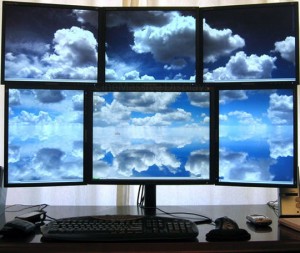I’m so eager to give you the #1 most helpful tip for making your computer more secure and less vulnerable to viruses and malware that I’m just going to jump right into it
//#1: Logon as standard user account that does not have administrative privleges!
For those of you who don’t know what that means, an account with administrative privleges may make changes to your computers settings and files. For day to day use, we simply do not need this ability. Whatever programs you use while you’re logged onto your computer with administrative privleges will have administrative access to your computer.
As an administrative user, when you click a “loaded” link in an email or a website, you can be directed to malware such as viruses, spyware and adware which will be able to deploy it’s payload on your computer. If you do the same as a standard user – the payload will be enumerably less able to harm your computer because it can only ruin your user account profile, not your whole Windows installation. Here is a link to an article “If you weren’t already worried about privledged users, you should be” where an industry professional is speaking about this concept as it relates to an enterprise setting, but the concepts are equally important at home and in the business.
So how do you make your user a standard user? Well to summarize the process before getting into the details, you’re going to need to make sure you have one account to use as an administrative account and an additional account to use as a standard, or restricted, user. This should be done on any computer running Windows 2000, Windows XP, Windows Vista and Windows 7. We’ll update this post with a link to an artical that describes the process of configuring user accounts and user account permisions.
//#2 Be sure that you have an anti-virus program installed with current virus definitions!
At a minimum, run Microsoft Security Essentials. Microsoft provides a free anti-virus program called Microsoft Security Essentials which provide basic anti-virus protection at no cost and free of advertisements and nag screens. For greater levels of anti-virus protection and configurability, consider anti-virus programs from other vendors such as Symantec – Norton Anti-Virus and Symantec Endpoint Protection, McAfee, NOD32, Kaspersky, AVG and Sophos just to name a few.
//#3 Surf safely even though you have anti-virus software installed and updated!
Just because you have anti-virus software installed and up to date doesn’t mean that you’re invulnerable. It’s a common misconception that, just because you have anti-virus installed, you’re 100% protected. Anti-Virus software is prophelactic, it offers protection but not invulnerability. A common response we get when diagnosing a virus is “but my anti-virus is up to date.” I like to say “If you think that you’re not going to get wet tromping around in the rain just because you’re wearing rain boots, you’re mistaken.” That’s what anti-virus is – protection – rain boots. Watch your step – Don’t click on suspicious links. If a friend messages you with a link, encouraging you to click on it, verify with them that they sent the link. Don’t install browser plug-ins, unless you’re sure they’re from a vetted source.
//#4 Be warry of the FREE word!
There is somebody (countless somebodies) out there preying on our love of free stuff! While there certainly are plenty of legitimate offers for free and valuable products and services – there are exponentially more bogus ones. When you include the word ”Free” in a seach using a seach engine such as Bing.com or Google.com you will need to be especially careful. For example – the term “free music download” is going to return results from sites that are designed to exploit you with advertisement of false or outragious offers for access to the free music. A very common attack method is to bundle malware into the free content you download. Another common method is to require to install a “Plug-In” to recieve the free content. When surfing the web, searching the web and checking your e-mail – be extra suspicious of anything free and resist the urge to be curious. Your assailant is counting on you not to resist the urge.






